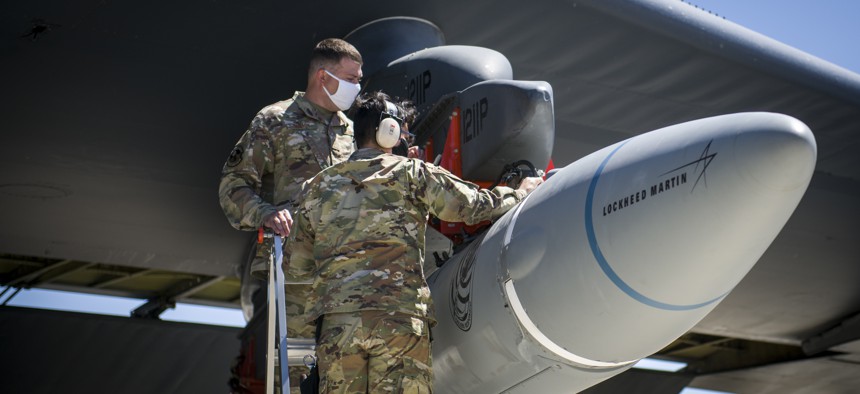
An AGM-183A Air-launched Rapid Response Weapon prototype is loaded under the wing of a B-52H Stratofortress at Edwards Air Force Base, California, Aug. 6. 2020. Giancarlo Casem/USAF
Hypersonic Missile Fails Test-Launch From B-52 Bomber
The Air Force called the ARRW failure “a setback.”
An under-development hypersonic missile failed to launch from the wing of a B-52 bomber during a highly anticipated flight test Monday.
The U.S. Air Force called the failure of the AGM-183A Air-launched Rapid Response Weapon a “a setback in demonstrating its progress in hypersonic weapons.” The U.S military has been racing against China and Russia to field numerous types of hypersonic weapons, which can fly at more than five times the speed of sound.
The ARRW was to launch from the B-52 over the Pacific Ocean. Instead, “the test missile was not able to complete its launch sequence and was safely retained on the aircraft which returned to Edwards AFB,” the Air Force said in an emailed statement.
“While not launching was disappointing, the recent test provided invaluable information to learn from and continue ahead. This is why we test,” Brig. Gen. Heath Collins, Armament Directorate program executive officer, said in the statement.
The Air Force wants to have operational ARRW missiles “in the early 2020s,” according to the statement.
“The weapon system is designed to provide the ability to destroy high-value, time-sensitive targets,” the Air Force said. “It will also expand precision-strike weapon systems’ capabilities by enabling rapid response strikes against heavily defended land targets.”
Missile maker Lockheed Martin declined to comment about Monday’s flight test and referred all questions to the Air Force “due to the classified nature of the program.”
Lockheed is developing several hypersonic weapons for the U.S. military. At the end of 2020, the company had “north of $3 billion” in hypersonic-related orders, Lockheed CEO Jim Taiclet said on the company’s last quarterly earnings call in January. Taiclet estimated Lockheed getting another $1.5 billion in hypersonic weapon orders this year.
“By the middle of the decade, it's conceivable that that number could be closer to $3 billion,” he said. “You'll start to see some of these limited rate production programs happening. Some of these programs will actually start going into full-scale production.”
New-generation weapons—like ARRW—are among a number of key upgrades planned for the B-52 in the coming years. These improvements will allow the half century-old Cold War-era bombers to remain an important piece of the Pentagon’s arsenal for decades to come.
Don't miss:





